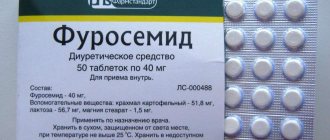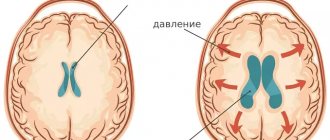Our clinic specializes in diagnosis and treatment of diseases of the nervous system, incl. non-surgical treatment of increased intracranial pressure and hydrocephalus. You will also find help with us in treatment of the consequences of intracranial hypertension: depression and nervous exhaustion, vegetative-vascular dystonia, headaches, visual disorders and others. We will be happy to help you!
- Increased intracranial pressure: treatment at the Echinacea clinic with and without medications
- Make a diagnosis
- Symptoms of increased intracranial pressure
- Causes and consequences of increased intracranial pressure
- What is intracranial pressure
- What is hydrocephalus of the brain
Increased intracranial pressure: treatment at the Echinacea clinic with and without medications
We actively use methods to normalize intracranial pressure, both classically and without drugs. Some simple measures may be enough to get you back to good health. The effect is usually noticeable already in the first week of treatment.
1. Unloading the venous bed of the head using special methods of soft manual therapy and osteopathy;
Normalization of intracranial pressure: for treatment, sometimes it is enough to eliminate the infringement of blood vessels by the vertebrae
2. Special gymnastics to reduce intracranial pressure (used by the patient independently, developed by the doctor after examining muscle tone); 3. Individual drinking/eating regimen.
Living with increased intracranial pressure is both unpleasant and harmful. The human brain cannot work normally under the influence of excess pressure ; moreover, slow atrophy of the brain substance , this leads to a decrease in intellectual abilities, disruption of the nervous regulation of internal organs (hormonal disorders, arterial hypertension, etc.). Therefore, we will take measures to normalize intracranial pressure as soon as possible.
In the treatment of increased intracranial pressure, it is important to reduce the release and increase the absorption of cerebrospinal fluid. Traditionally, it is customary to prescribe for this purpose drugs that reduce the production of cerebrospinal fluid and improve venous outflow (evacuation of venous blood from the cranial cavity). Often it is enough to take the medicine 1-2 times a week.
But still, we strive to free our patients from constant medication use. There are two ways to do this:
- If possible, eliminate the cause of increased intracranial pressure and hydrocephalus;
- Use more non-drug methods for treating cerebral hydrocephalus.
What to do in very severe cases
In very severe cases (for example, cerebrospinal fluid block after neurosurgical operations or congenital cerebrospinal fluid block), surgical treatment is used. For example, a technology has been developed to implant tubes (shunts) to drain excess cerebrospinal fluid.
List of effective tablets for high blood pressure
To reduce intracranial pressure, complex therapy is prescribed.
Furosemide
The medicine is classified as a diuretic. The active substance of the same name has a diuretic and moderate antihypertensive effect. The effect of the drug is noticeable within an hour. Tablets are prescribed from ½ to 3 tablets per day. It is recommended to drink in 2 doses. For children, the dosage is calculated by weight.
Furosemide serves as a diuretic
Contraindications for use:
- hypotension;
- narrowing of the aorta and heart disease;
- hepatic and diabetic coma (hyperglycemic);
- narrowing of the urethra;
- high levels of uric acid in the blood;
- perinatal and lactation period.
- acute renal failure.
Pharmacy price of tablets is 35 rubles.
Piracetam
Belongs to the group of nootropic drugs. The name of the drug is identical to the active substance. Normalizes cerebral circulation, promotes activation of attention and memory function. Produced in tablets and capsules. Oral medications are prescribed to be taken 2-4 times a day, 200 mg.
Piracetam is taken to normalize blood circulation in the brain
Contraindicated for children under one year of age, pregnant and lactating women, patients with chronic renal failure.
The price of tablets and capsules varies from 50 to 150 rubles, depending on the manufacturer and dosage.
- Orthopedic knee pads for arthrosis
Paracetamol
Non-narcotic analgesic. The active component corresponds to the name of the drug. Relieves headaches and reduces temperature. The maximum single dose of tablets in adults and children aged 12+ is 1 g; no more than 4 doses are allowed per day.
Paracetamol is a popular headache reliever.
Do not use for pathologies of the renal apparatus, liver diseases, alcoholism, or blood diseases.
Tablets are sold at prices ranging from 16 to 40 rubles.
Captopril
Represents a group of vasodilator drugs that lower intracranial pressure. The active substance is identical to the name of the drug. Effectively constricts blood vessels, the effect of the medicine is observed after a quarter of an hour. The tablets are placed under the tongue and held until completely dissolved. The maximum dose is 3 pcs., with an interval of 20 minutes.
Captopril constricts blood vessels and reduces intracranial pressure
Do not use during the perinatal and lactation period, in the treatment of children under 16 years of age, or with renal decompensation.
You can buy it for 145 rubles.
Picamilon
Nootropic, the active component is represented by a complex chemical compound N-nicotinoyl-gamma-aminobutyric acid sodium salt. Stabilizes blood circulation in the brain, helps improve cognitive functionality. Treatment is long-term, 1.5-2 months. Take 60-150 mg daily, 2-3 times a day.
- Allergen panels (by blood)
Picamilon improves cognitive function of the brain
Not prescribed for children under 3 years of age, women during pregnancy and breastfeeding, and patients with severe renal pathologies.
Cost from 90 to 120 rubles.
Glycine
Neuroprotector with active non-essential amino acid microencapsulated glycine. Stabilizes the psycho-emotional state, improves brain activity, and makes it easier to fall asleep. Available in the form of small sublingual tablets. Adults are prescribed 1-2 tablets 3 times a day, children ½-1 tablet. Approved for use from any age after consulting a doctor.
Glycine stabilizes the psyche and is used to restore sleep
Has no contraindications. Exception: individual reactions of the body to amino acids.
Can be purchased for 40 rubles.
Cavinton
Nootropic drug. The drug is based on active vinpocetine, synthesized from plant materials (minor periwinkle). Corrects blood circulation in the brain, moderately lowers blood pressure, stimulates memory. The tableted medicine is taken 1-2 tablets 3 times a day.
Cavinton improves blood circulation in the brain
- How do antihistamines work?
Not prescribed for all forms of arrhythmia, ischemia, and for women during the perinatal and lactation periods.
Price – 670 rub.
Magnesium (magnesium tablets)
It is a dietary supplement containing magnesium ascorbate (300 mg) and magnesium citrate (200 mg). Helps improve blood circulation in the brain, relieves spasmodic conditions, and has a calming effect on the nervous system. Produced in capsules. Take 1-2 pcs. 3 times/day during meals.
Magnesium is a biological additive that calms the nervous system
An absolute contraindication is an increased level of magnesium in the body. Relative (relative) – perinatal and lactation periods in women.
The price for 100 capsules ranges from 1200 to 1600 rubles.
Make a diagnosis
Intracranial pressure can be directly measured only by inserting a special needle with a pressure gauge connected to it into the fluid cavities of the skull or spinal canal. Therefore, we do not use direct measurement of intracranial pressure.
On the left is an MRI scan of a normal brain. The brain matter is shown in gray, the cerebrospinal fluid is in white. Normal size of the fluid spaces of the brain (they are slit-like). The ventricles are visible inside the brain. The subarachnoid spaces are the white border around the brain.
In the center there is internal hydrocephalus. Excessive accumulation of cerebrospinal fluid inside the brain in the form of a butterfly is visible. On the right is external hydrocephalus. External hydrocephalus is also an excessive accumulation of cerebrospinal fluid outside the brain in the form of a wide white border. The volume of the brain matter is reduced - brain atrophy from fluid pressure
We can confidently judge the increase in intracranial pressure based on the following data:
- Dilation and tortuosity of the fundus veins is an indirect but reliable sign of increased intracranial pressure;
- Expansion of the fluid cavities of the brain (internal hydrocephalus of the brain, external hydrocephalus) and external hydrocephalus (rarefaction of the medulla) along the edge of the ventricles of the brain, clearly visible on computed x-ray tomography (CT) or magnetic resonance imaging (MRI);
- Violation of the outflow of venous blood from the cranial cavity, established using ultrasound vascular studies.
How much the brain suffers from increased intracranial pressure can be judged from EEG data. The gold standard for instrumental examination of patients in our clinic is an assessment of symptoms, brain tomography , fundus images and EEG .
Good optics helps us see the subtle nuances of the fundus vessels
Echoencephalography (Echo-EG) provides indirect and not always reliable data on increased intracranial pressure; it is less reliable than CT and MRI, so we do not use this method.
Symptoms and treatment
Symptoms of intracranial pressure
Change in pupil reaction;- Swelling of the optic nerve;
- Problems with vision (peripheral vision is impaired first, and then central vision). Acuity decreases, diplopia occurs;
- Reduced hearing threshold;
- Dyspeptic syndrome consisting of nausea and vomiting;
- Severe headache that lasts for a long period of time, a feeling of constant fatigue and drowsiness;
- Pain when turning the head, as well as when sneezing and coughing;
- Sudden hyperhidrosis (production of a large amount of sweat), a sharp decrease in blood pressure;
- Irritability, nervousness, decreased ability to work;
- The occurrence of hematomas in the periorbital area;
- Pain in the cervical vertebra and spinal cord;
How to treat increased intracranial pressure?
It is necessary to understand that the condition in question is not an independent nosological unit, but a symptom of some disease that affects the human nervous system. Only after the pathology, the presence of which leads to an increase in intracranial pressure, has been identified, will it be possible to draw any conclusions. After all, it is reliably known that treatment of intracranial pressure (increased), equally as treatment of any other somatic pathology, can only be effective if its root cause is determined for the purpose of further elimination, and nothing else.
It is in order to correctly identify the root cause of the pathology that it is necessary not only to conduct a number of laboratory and instrumental studies, but also to consult a competent specialist who can interpret the results obtained, compare them with indicators of the objective condition, and then draw appropriate conclusions and select the correct treatment that will will relieve the symptoms discussed above.
If you notice signs of increased intracranial pressure, do not delay your visit to the doctor, this will need to be done as soon as possible, since what matters here is when exactly the necessary treatment will be prescribed.
The most experienced and competent neurologist in Tushino conducts an appointment in our clinic. Hurry up to sign up, because if treatment is started on time, it will be much easier to get rid of the pathological condition before the disease manifests itself and does not lead to undesirable consequences.
Get advice on visiting a neurologist. Consultation on the service does not oblige you to anything.
Symptoms of increased intracranial pressure
Increased pressure on the brain substance can disrupt the functioning of the central nervous system. Hence the characteristic symptoms:
- Heaviness in the head or headaches that increase in the morning or in the second half of the night;
- In severe cases, nausea and/or vomiting in the morning may occur;
- Vegetative-vascular dystonia (sweating, a drop or increase in blood pressure, palpitations, lightheadedness, etc.) is an almost obligatory symptom;
- Fatigue, “dullness”, easy exhaustion during work or study loads;
- Nervousness;
- “Bruises” under gases (if you stretch the skin under the eyes in the area of the “bruise”, dilated small veins are visible);
- Possible decrease in sexual desire and potency;
- If the human body is in a horizontal position, cerebrospinal fluid is released more actively and absorbed more slowly, so intracranial pressure and its symptoms tend to peak in the second half of the night or in the morning;
- The lower the atmospheric pressure, the higher the intracranial pressure, so the deterioration of the condition is associated with changes in weather.
Drugs for intracranial pressure in children
In children, pressure indicators are flexible and change depending on the child’s well-being and activity. There is no need to correct blood pressure or use medications. In serious cases, a pediatric neurologist helps optimize cerebral circulation processes and stabilize the condition with the help of a medicine for intracranial pressure for children - glycine. Reviews from people advise: to relieve a child of unpleasant symptoms, you can give him a relaxing massage or physical therapy. Swimming may help. Prescribed medications include:
- homeopathic remedies;
- vascular;
- vitamins;
- dietary supplements;
- sedatives.
Causes and consequences of increased intracranial pressure
The reasons we find most often:
- disruption of the outflow of venous blood from the cranial cavity
- hypoxia (oxygen starvation)
- suffered a traumatic brain injury (even a very old one, up to birth trauma)
- meningitis or encephalitis
- congenital structural features of the central nervous system (Arnold-Chiari anomaly, congenital intracranial hypertension, etc.);
- poisoning with brain damage.
Consequences As a result of the disease, brain cells are gradually destroyed, and their place is filled with fluid. The functions of systems controlled by the brain become disordered, and complete or partial loss of vision, hearing, memory, potency, miscarriage, depression, nervous exhaustion and other health problems may occur.
On the left is a normal brain, the liquid (cerebrospinal fluid) is indicated in white. On the right is untreated internal hydrocephalus: brain atrophy, almost the entire cranial cavity is occupied by fluid.
What is intracranial pressure
Wise nature placed the human brain in a protective liquid environment ( subarachnoid fluid spaces ) and provided it with internal fluid cavities ( ventricles ). Thus, the brain is actually suspended in a special fluid - cerebrospinal fluid (also known as cerebrospinal fluid or CSF ). The cerebrospinal fluid is in the cranial cavity under a certain pressure. It is the pressure of the cerebrospinal fluid on the brain that is called intracranial pressure .
A normal level of intracranial pressure is very important for the proper functioning of the brain and all processes subordinate to it. We often see a total improvement in the well-being of our patients as intracranial pressure normalizes.
What is increased intracranial pressure? All fluid spaces and ventricles are interconnected by ducts. The liquor is constantly circulating. In some parts of the brain it is released, and then flows through the cerebrospinal fluid ducts to other parts of the brain, where it is absorbed into the bloodstream. Complete renewal of the cerebrospinal fluid occurs on average 7 times a day. Excessive accumulation of cerebrospinal fluid causes an increase in its pressure on the brain substance. This is called increased intracranial pressure (intracranial hypertension).
Three common causes of chronic increased intracranial pressure:
- too much cerebrospinal fluid is released;
- the cerebrospinal fluid is not absorbed fully enough;
- the patency of the cerebrospinal fluid circulation pathways is impaired.
What is hydrocephalus of the brain, external hydrocephalus
If intracranial pressure is increased significantly and for a long enough time, the fluid cavities of the brain may expand; this expansion is called internal or external hydrocephalus. Since the cranial cavity is a closed space, the expansion of the fluid cavities of the brain occurs due to a decrease in the mass of the brain matter itself. To protect you from the death of working brain tissue, we will offer you a course of medications, in combination with a set of exercises to reduce intracranial pressure and, if necessary, osteopathic correction.
External hydrocephalus (brain) - expansion of the external cerebrospinal fluid spaces of the brain (subarachnoid spaces).
Internal hydrocephalus (brain) - expansion of the internal liquor cavities of the brain (ventricles).
Our clinic pays great attention to finding the root causes of such a condition as increased intracranial pressure. In this case, treatment can be kept to a minimum, and our assistance to patients will be reliable.











